Of Peace and Christmas Truces Friday, December 19th, 2008
|
|
|
|
|
A Very Happy Christmas
Joyeux Noel
Vrolijk Keerstfeest
Froheliche Wienatchten
Nodlaig Mhaith Chugnat
Buone Feste Natalizie
Kala Chrristouyenna
Zorionak eta Urte Berri On!
_
We at the Plugstreet Project wish you all the compliments of the Season and pause to remind you that it is our study area that the famous Christmas Truce between British and German soldiers took place in No Man’s Land.
_
Finding the Archaeology of such an event may be impossible but we hope the spirit of this event pervades your Christmas and New Year.
_
In the spirit of international cooperation that pervades the project we wish you a Happy Christmas in English, French, Flemish, German, Irish, Italian, Greek and Basque.
_
We also think of our friends who are far away, some of them in dangerous places and wish them Peace.
_
All Good Wishes
_
The Project Team
|
|
|
|
|
|
Filed under: Uncategorized by
admin
Add a Comment »
|
|
Remembrance Tuesday, November 11th, 2008
|
|
|
|
|
11:00 hrs on the 11th November.
_
Our last surviving veterans in Whitehall, Prince Charles at Verdun and silence across so much of the world.
_
We Will Remember Them!
_
As archaeologists in this sector we are become agents of remembrance as we excavate the sites and reveal the human stories.
_
Jakob Hones,Albert Thielecke, Leopold Rotharmel, our Anzac and others, as yet un-named, we in No Mans Land are proud to have brought in from the cold…
_
We remember you.
|
|
|
|
|
|
Filed under: Archaeology by
admin
Add a Comment »
|
|
Conference Announcement Wednesday, October 29th, 2008
|
|
|
|
|
Dear all
a chance for those of you that have been following the blog to come and meet a number of the key players and learn more about the archaeology of the Great War, with Plugstreet featuring prominently! Oxford University is holding a day school on Saturday 28th February 2009 at Wellington Square. The programme is detailed below (with an asterisk adjacent to Plugstreet project team members…)
_
The Great War: the archaeology of the first of the 20th Century’s Great Conflicts
_
‘Our knowledge and understanding of the First World War is considerable and yet much remains hidden. As we rapidly approach a time when there will be no surviving veterans of the conflict, the Great War through its archaeology offers a relatively new phenomenon that utilises familiar methodologies as well as innovative approaches to gain a better understanding of the war. This day school draws together a number of leading experts on Great War archaeology to examine a broad range of themes – from the sands of the desert war to the mud of Flanders and the material traces of those who fought
_
09:45 – Introduction
10:15 – Dr Nicholas Saunders* – Trench Art: Material Culture and the Antrhopological Dimensions of Great War Archaeology
11;15 – Coffee/tea
11:45 – Richard Osgood* & Martin Brown* – ‘We shall Certainly Change The Geography: Soldiers, civilians and the battle of Messines
12:45 – Lunch
14:00 – Peter Chasseaud* – ‘Imaging Golgotha – Aerial Photpgrahs and Trench Maps of the Western Front’
15:00 – Coffee/tea
15:30 – Dr Neil Faulkener – ‘Trains Trenches and Tents: the Archaeology of Lawrence of Arabia’s War’
16:30 – Jon Price – ‘Rise and Deride This Sepulchre of Crime: The Role of Archaeology and the Missing Dead of the Great War’
_
Programme Fee
Tuition: £40.00
Catering
Hot lunch: £10.00
Baguette lunch: £2.50
_
Join online: https://www.conted.ox.ac.uk/courses/apply/apply_online.php?id=O08P158AHJ
For an application form, click here:
http://www.conted.ox.ac.uk/courses/files/O08P158AHJ_2_Application.pdf
_
Hope to see you there!
|
|
|
|
|
|
Filed under: Conferences & Lectures by
admin
Add a Comment »
|
|
Fields of Conflict Tuesday, October 21st, 2008
|
|
|
|
|
Over the past few days an number of the project team have been attending the 5th Fields of Conflict conference in Gent (Belgium). FOC exists to bring together specialists in Conflict Archaeology from around the globe. Delegates included Doug Scott, who virtually invented battlefield archaeology when he investigated the site of Little Bighorn, Glenn Foard, who has worked on Civil War sites from the UK and Susana and Achim Wilbers-Rost from the site of the Varian disaster (AD9) at Kalkriese. Inevitably the range of papers was wide, diverse and stimulating.
_
Project members Peter Masters, Birger Stichelbaut, Jon Price and Martin Brown all presented on Great War Archaeology, heavily drawing on the Plugstreet Project. Peter and Birger spoke on their remote sensing work, marrying geophysics, aerial photographs and map regression work, wowing the audience with their results. Jon spoke about methodological approaches to excavation. Martin spoke on the subject of looking over the parapet, which explored the wider frame in which excavations on the Western Front exist – militarised landscapes, civilians, training and the international links of the war.
_
Also speaking was Veerle Hendricks from the Flemish Heritage Institute, the VIOE. Veerle is writing up the A19 excavations around Ieper from 2002 onwards, including sites dug by No Man’s Land. It was her first major conference paper and she performed very well and wasn’t fazed by the eminent panel of delegates.
_
It wasn’t all work and we did enjoy some lovely Belgian beer, including some rarities and oddities, while Oude Druide is nice we weren’t so keen on Spook! Birger was an excellent local guide and we especially salute the Ratz Bar, opposite the Opera House!
|
|
|
|
|
|
Filed under: Conferences & Lectures by
admin
Add a Comment »
|
|
Poodlefaking Friday, October 10th, 2008
|
|
|
|
|
You may well ask…
_
It’s a term used in the Indian Army (pre 1947) by officers of other junior officers who were seen out with ladies without their Commanding Officers’ permission.
_
One team member was accused of it by the University Officer Training Corps’ regular officer when at Cambridge.
_
We were surprised to see it here:
http://news.bbc.co.uk/
_
In an article of forgotten words you still love…
|
|
|
|
|
|
Filed under: Uncategorized by
admin
Add a Comment »
|
|
Photographs by Frank Hurley Friday, October 3rd, 2008
|
|
|
|
|
Frank Hurley was the photographer on the Shackleton expedition to the South Pole and then went on to accompany Anzac 3 Div at the Battle of Messines, where he took some remarkable photographs of the battlefield.
_
Hurley felt that his pictures did not capture the full horror of the things he had seen so manipulated images, creating composites of scenes. Some thought this was clearly wrong but others feel it was an appropriate artistic response to the war.
_
An new exhibition at Charleston Farm outside Lewes in Sussex addresses this issue and displays a number of his images.
_
http://www.charleston.org.uk/visit/gallery.html
_
Charleston has its own Great War heritage of a kind in that the Bloomsbury Set holed up there to avoid zeppelin attacks and to be pacifists. Meanwhile the nearby Firle Place was used as a hospital for Australian troops.
_
You can see Hurley pictures on the AWM website:
_
www.awm.gov.au/captured/official/hurley.asp
_
You can also find examples elsewhere on this blog where they are accompanied by photos of the archaeology, landscape and team inspired by Hurley’s work and taken by Ian, our own photographer, who was using a plate camera, just like Hurley’s own.
|
|
|
|
|
|
Filed under: A Dig Diary by
admin
Add a Comment »
|
|
Read All About It Wednesday, October 1st, 2008
|
|
|
|
|
The Plugstreet Project is featured in this month’s “Britain at War” Magazine – available in the UK via WH Smith and Sainsbury’s and all good newsagents.
_
BAW includes a double page spread on the discovery and excavation of the Australian casualty. It includes both text and a number of photographs of the site, the finds and archaeologists at work.
_
www.britain-at-war-magazine.com
_
Thanks to our good friend Mark Khan for the publicity and for his journalistic skill in drafting the story.
_
Britain at War will include a larger piece on the dig in a coming edition. In the meantime this month includes interesting pieces from both World Wars, including a fascinating article on the siege of Tsingtao in 1914, when a combined Anglo-Japanese force assaulted and took the German colony in China. I suspect I’m not alone in never having heard of this action before!
|
|
|
|
|
|
Filed under: A Dig Diary by
admin
Add a Comment »
|
|
Down the Road… Thursday, September 18th, 2008
|
|
|
|
|
According to newspaper The West Australian:
_
“Details about a new cemetery for 400 Australian and British World War I soldiers found in a mass grave in France are set to be unveiled later this week.”
_
The paper then goes on to report the plans to exhume the bodies of the soldiers from Fromelles, south of Plugstreet on the Aubers Ridge. Once exhumed there will be attempts to identify the bodies before all are reburied.
_
The budget is rumoured to be $10 million Aus. and some of that money will be coming from the UK as just over half the bodies are Brits, even though the Australians have led on the project following pressure at home from descendants.
|
|
|
|
|
|
Filed under: Archaeology by
admin
Add a Comment »
|
|
Across the site Tuesday, September 9th, 2008
|
|
|
|
|
Although incredibly powerful, the find of the Australian soldier was not the only part of the site this year. The team also worked very hard to accomplish many other elements. Even more of the battle site was subject to geophysical survey and four other trenches were opened. These showed:
_
1) the complete plan of the German bunker seen in part last year
_
2) more of the Lewis gun position on the eastern lip of Ultimo crater
_
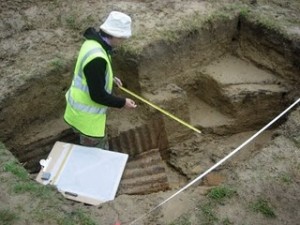
Avril records the Lewis gun post
_
3) a major wriggly-tin-lined redoubt was located on the south edge of Ultimo crater
_
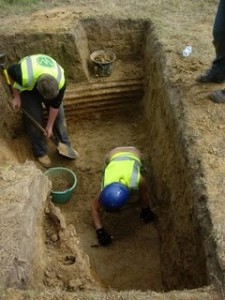
Moving into the redoubt
_
4) at some depth, a massively-engineered timber structure was encountered. Large timbers were found revetted with timber uprights. A gas cape or similar was present here too. Is this a dugout? A German trench mortar position? Something else? Whatever it is, the timbers all appear to have been pushed over in one direction – the blast of the mine?
_
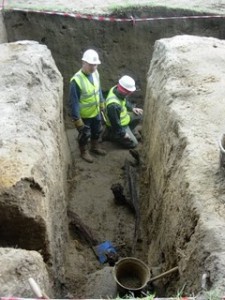
Keith and Jon working with the German feature
|
|
|
|
|
|
Filed under: A Dig Diary by
admin
Add a Comment »
|
|
What they Carried Thursday, September 4th, 2008
|
|
|
|
|
In addition to all the military elements that the Australian soldier had with him, there were some other effects.
_
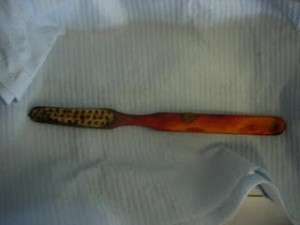
His toothbrush marked – Flexadent France
_
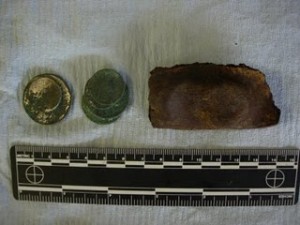
His wallet – some French Francs clearly 1916 dated
_
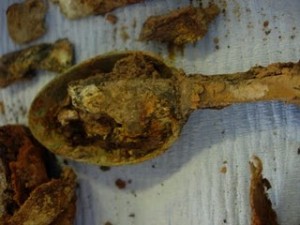
His spoon (with razor on the top)
_
Finds like these added still more to the overall picture of the man.
|
|
|
|
|
|
Filed under: A Dig Diary by
admin
Add a Comment »
|
|
|
|
|
|